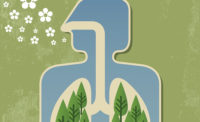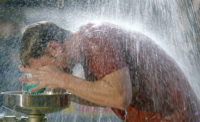Respiratory protection is a perennial “Top 5” most-cited OSHA violation. In 2014, there were 3,879 violations, ranking fourth for the seventh year in a row.1 Following are the 12 most common compliance mistakes. With just a little diligence, these mistakes are all easily avoidable. Let’s review each one.
1. Lack of a written program
According to 1910.134(c) and (c)(1), an employer is required to develop and implement a written respiratory program with required worksite specific procedures and elements for required respirator use in any workplace where respirators are necessary to protect the health of the employee or whenever respirators are required by the employer.
The program must outline:
• Respirator-selection process
• Medical evaluations
• Fit testing
• Procedures for use
• Procedures and schedules for cleaning, disinfecting, storing, inspecting, repairing and discarding
• Procedures to ensure adequate air quality, quantity and flow
• Training in respiratory hazards
• Training in use limitations and maintenance
• Procedures for regularly evaluating the program’s effectiveness
Even if respirators are worn voluntarily, employers must still provide a written program to ensure that any employee using a respirator voluntarily is medically able to use that respirator, and that the respirator is cleaned, stored and maintained so its use does not present a health hazard to the user.2 The only time written programs are not required is in the case of voluntary use of filtering facepieces (better known as “dust masks”) (1910.134(c)2,(i,ii)).
In this digital age, why does OSHA specifically mandate that the program be written? OSHA has found health and safety programs to be more effective if procedures are available in hard copy for study and reference. A written plan also ensures any unique characteristics of the specific worksite are considered. OSHA believes, “Developing the written program encourages [the employer] to thoroughly assess and document information pertaining to respiratory hazards posed to employees” under normal conditions or reasonably foreseeable emergencies.3
Essentially, a compliant program must be: written, worksite-specific, reviewed for effectiveness regularly, and trained upon regularly.
2. Failure to fit test
Employees must be fit tested with the same make, model, style and size of respirator that will be used, according to 1910.134(f). Employees should be retested annually when there is a change in the type of respirator used, or a change in an employee’s physical condition, such as an obvious change in body weight. Fit testing records must be detailed and retained until the next fit test. If an employee wears glasses, goggles or personal protective equipment, the employer must ensure that the equipment doesn’t interfere with a facepiece’s seal.
3. Permitting facial hair
Employers must not allow an employee with facial hair or any condition that limits a facepiece seal or valve function to wear a tight-fitting facepiece (1910.134(g)(1)(i)(A)). Loose fitting respirators – an alternative option often explored by employers – do not require fit testing.
4. Failure to air test
Employers are required to ensure that the breathing air going into a respirator meets Grade D standards described in ANSI/Compressed Gas Association Commodity for Air, G-7.1-1989 (1910.134(i)(1)(ii)).
Requirements include:
• Oxygen content of 19.5 – 23.5%
• Hydrocarbon content of 5 milligrams per cubic meter of air or less
• Carbon Monoxide (CO) content of 10 parts per million (ppm) or less
• Carbon Dioxide (CO2) content of 1,000 ppm or less
• Lack of noticeable odor
Verification can be conducted by an air test, available from multiple sources. This is not an exhaustive list, but instead the major components. The complete standard can be purchased from the Compressed Gas Association.
5. No medical evaluations
Medical Evaluations are to be provided at no cost to employees (1910.134(c)(4)). Evaluations are intended to determine the employee’s ability to use a respirator. They must be completed before an employee is ever fit tested or required to use the respirator. The employee must also complete a questionnaire found in Appendix C, Part A, Sections 1 and 2 of the standard (1910.134(e)(2)(ii)).
6. Failure to calibrate CO monitors
Whenever using an oil-lubricated compressor, employers shall use high-temperature or carbon monoxide alarms in order to monitor CO levels to the respirator user(s) (1910.134(i)(7)). Several manufacturers offer CO monitors, often combined with air filtration, to help maintain the Grade D breathing air requirement discussed previously.
Sensors inside the monitors must be calibrated. This procedure will vary, depending on make and model of the unit. Some are easier to conduct than others, which is often given as an “excuse” for not being completed. Most manufacturers recommend monthly calibrations but check the manufacturer’s guidelines.
7. Failure to maintain records
Part of the employer’s written program needs to designate how written information will be established and retained, particularly regarding medical evaluations, fit testing, and the respirator program in general. A well-executed system will assist employers in auditing the effectiveness of their program and provide necessary evidence in the event of an OSHA visit (1910.134(m)).
8 & 9. Modifying and using non-approved respirators
Respirators must be NIOSH approved and maintain the NIOSH compliance for which it was approved. The National Institute for Occupational Safety and Health (NIOSH) tests and certifies respirator assemblies. It is OSHA’s job to enforce the proper use of NIOSH-approved respirators.
According to 1910.134(d)(1)(ii), “the employer shall select a NIOSH certified respirator. The respirator shall be used in compliance with the conditions of its certification.” Substitutions of any component pieces not included in the NIOSH Approval Label supplied with each approved respirator are not permissible.
10. Using incorrect filters
Before beginning a respiratory protection program, employers must evaluate workplace hazards. When the hazards dictate that respiratory protection is required, the employer must be able to identify those hazards. When using an air purifying respirator (powered or non-powered), they must determine whether the hazard is an organic vapor, acid gas, or a particulate, in order to select the correct filter. Material Safety Data Sheets (MSDS) or the NIOSH Pocket Guide to Chemical Hazards will help with this.
Employers must ensure all filters, cartridges and canisters used in the workplace are labeled and color coded with NIOSH-approved labels, and that the labels are not removed and remain legible (1910.134(j)).
11. Mixing breathing air lines
Employers shall ensure that breathing air couplings are incompatible with outlets for non-breathable worksite air or other gas systems. No asphyxiating substance shall be introduced into breathing air lines (1910.143(i)(8)). This is the reason manufacturers offer so many different hose fitting options. Breathing air must have its own designated fitting, separate from any other air or gas on site.
12. Improper air source
Each NIOSH-approved respirator assembly is tested and assigned a permissible air source, whether it is supplied air or a powered air unit. Using a respirator assembly approved for supplied air with a powered air unit would be a violation, and vice versa.
Compressors used to supply breathing air have their own requirements (1910.134(i)(5)). They must:
• Prevent entry of contaminated air into the air supply
• Minimize moisture content
• Have suitable in-line air purifying sorbent beds and filters
• Have a tag at the compressor noting the most recent filter change date and the responsible party
• Use a high-temperature or carbon monoxide alarm (for oil-lubricated units)
• Ensure breathing air couplings are incompatible with outlets for non-breathable air or gas
References
1 Industry Profile for OSHA Standard 19100134. http://www.ehso.com/css/oshaviolations.php
2 Voluntary Use Policy. https://www.osha.gov/SLTC/etools/respiratory/voluntaryuses.html
3 Small Entity Compliance Guide for the Respiratory Protection Standard. https://www.osha.gov/Publications/3384small-entity-for-respiratory-protection-standard-rev.pdf



